Vertical Vs Offset Smoker: Which One Is Best For You?
Choosing the right smoker for your barbecuing needs can be challenging. Especially when faced with the decision between a vertical smoker and an offset smoker. Here’s the scoop on vertical vs offset smoker!

Both options have their advantages and drawbacks, which can significantly impact the flavor and tenderness of your smoked meats.
Understanding the key differences between the two will help you pick an informed decision that aligns with your preferences and space constraints and pick a good smoker.
Before investing in a smoker, the first thing that you must do is carefully weigh the pros and cons of each type.
Consider factors such as fuel consumption, cooking speed, capacity, and the available square inches of cooking space in your cooking area.
Whichever smoker you decide to purchase, you can rest assured that either the vertical or offset smoker will elevate your barbecue experience and satisfy your taste buds.
Offset vs Vertical Smoker Fundamentals
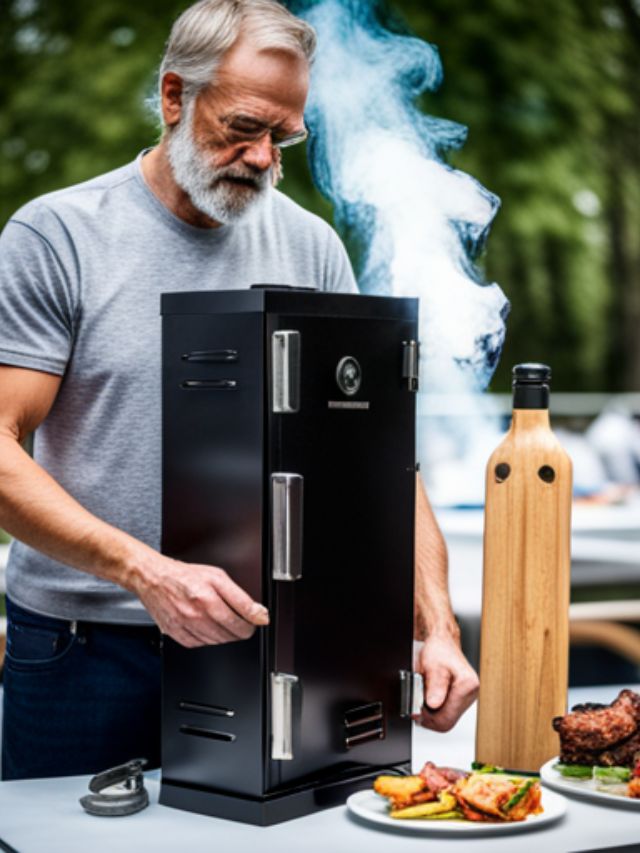
Understanding Offset Smokers
Regular offset smokers offer a simple design and typically provide a larger cooking capacity.
Offset smokers, also known as horizontal smokers, have a distinct design with two separate chambers.
The main cooking chamber is for cooking the meat, while the side chamber (firebox) generates heat and smoke.
The design of the horizontal offset smoker promotes an indirect heat flow, providing even temperature distribution and a slow, steady cooking process that uses much fuel.
Using a standard offset smoker grill often results in juicy, smoky, and tender meat.
An advantage of horizontal smokers is their large cooking capacity.
They are ideal for large cuts of meat and can cater to big gatherings.
Moreover, they can simultaneously smoke and grill food, offering versatility in cooking styles.
Understanding Vertical Smokers
Vertical smokers have an upright and compact design, making them suitable for small spaces.
They typically feature a stacking system of racks or horizontal shelves, allowing for efficient use of space.
The heat source is situated at the bottom of the cooking chamber or smoker, and the heat and smoke rise naturally to cook the meat evenly.
The water pan, which can also be used as a heat sink, is placed at the bottom rack in the cooking main chamber, which is above the heat source.
The meat should be placed on a rack above the water pan.
Some benefits of the vertical models of smokers include:
Vertical smokers are compact and efficient, with a smaller footprint due to their upright design.
They often feature a dual-door system, allowing for convenient refueling during the cooking process.
Additionally, vertical grills or smokers have a reputation for using less fuel and cooking meat faster than their offset counterparts.
- Space-efficient: Their small footprint helps them fit in limited areas, making them perfect for urban settings.
- Fuel-efficient: A vertical smoker generally uses less fuel than a traditional offset smoker, saving on costs in the long run.
- Faster cooking: Meat usually cooks faster in a vertical smoker than horizontal smoker.
- Dual-door design: This design allows easy access to the fuel source, making it simple to add fuel mid-cooking without disturbing the cooking process.
Despite their benefits, it is essential to note that vertical smokers are exclusively designed for smoking and smoke control, and cannot grill food like their horizontal counterparts.
Both offset and vertical smokers have their advantages and drawbacks, and the right choice depends on individual preferences, cooking style, available space, and intended use.
Heat and Smoke Management

Heat Distribution in Offset and Vertical Smokers
Offset smokers typically have a horizontal orientation and utilize a fire box offset to the side of the cooking chamber for the heat and smoke needed to cook meat.
The heat source in offset smokers produces indirect heat, allowing for even heat distribution and temperature control.
On the other hand, vertical smokers stand upright and use the natural thermodynamics to move heat and smoke through the vertical chamber and over the meat.
Due to their vertical design, heat, and smoke naturally flow upwards, resulting in a more efficient heat transfer.
| Smoker Type | Heat Distribution |
| Offset | Indirect heat from the firebox, even distribution |
| Vertical | Natural thermodynamics, efficient heat transfer |
Managing Smoke and Temperature Control
In offset smokers, an internal damper helps control the heat, or temperature range and smoke generated from the box smokers or fireboxes.
Adjusting the damper will either increase or decrease the flow of air, which impacts the temperature in the cooking chamber.
Additionally, offset smokers usually have a chimney to release excess smoke and further control the cooking environment.
Similarly, vertical smokers also have a chimney and an internal damper for regulating smoke and temperature during the cooking process.
Thanks to the dual-door design of most vertical smokers, it is easy to add fuel while cooking .
Moreover, vertical smokers tend to use less fuel than offset smokers, making them more energy-efficient and faster at cooking meat.
Both offset and vertical smokers are equipped to manage heat and smoke effectively.
However, vertical smokers may have a more efficient heat transfer process due to their vertical orientation.
While offset smokers provide more control over indirect heat generated in the cooking chamber.
Types of Smokers Based on Fuel

Here’s the scoop on the different types of smokers based on the fuel they use, including charcoal, wood, electric, propane, and pellet smokers.
Charcoal Smokers
Charcoal smokers are a popular choice among barbecue enthusiasts for their authentic smoky flavor.
They use charcoal briquettes or lump charcoal as their primary fuel source.
The heat from the charcoal cooks the food, while the smoke from the charcoal fire imparts a unique flavor.
Some vertical and offset smokers use charcoal as their fuel source.
Pros:
- Authentic smoky flavor
- Affordable fuel source
Cons:
- Requires constant monitoring and adjusting of temperature using the temperature gauge
- Can be messy
Wood Smokers
A wood smoker, similar to a charcoal grill or smoker, produces a distinct flavor due to its all-natural wood fuel.
Various types of wood, like hickory, oak, and fruitwoods, can be used in these smokers to create a range of flavors.
Traditional and reverse flow offset smokers are examples of wood smokers.
Pros:
- Natural and versatile flavor
- No chemical additives
Cons:
- Can be more challenging to maintain consistent temperatures
- Requires a supply of wood
Electric Smokers
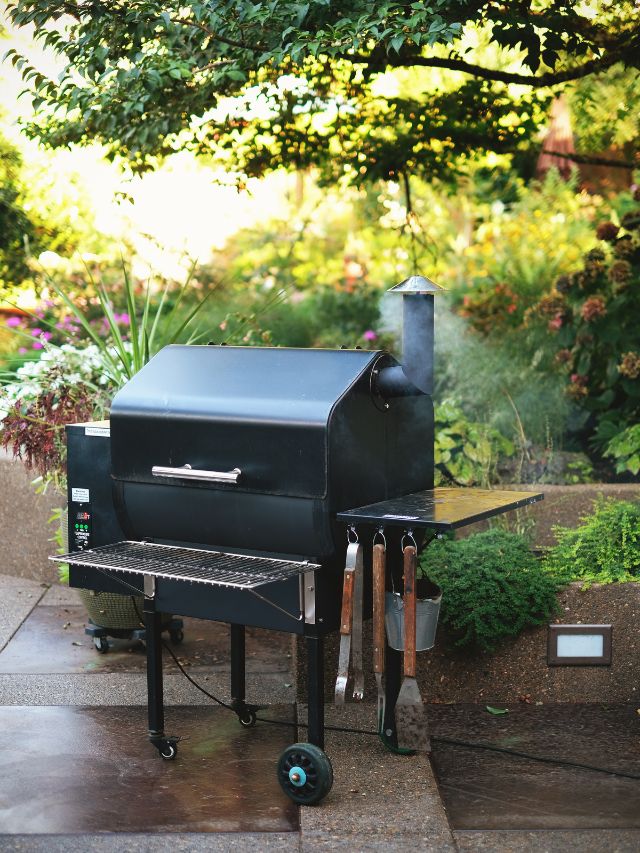
Electric smokers are a convenient and user-friendly option.
They use an electric heating element to generate the heat required for cooking, while wood chips or pellets are added to create the smoky flavor.
These smokers are typically vertically oriented.
Pros:
- Easy to set and maintain temperatures
- Less mess compared to charcoal or wood smokers
Cons:
- Lacks the same robust flavor as charcoal or wood smokers
- Dependence on electricity limits portability
Propane Smokers
Propane smokers use propane gas as their primary fuel source.
They are often similar in design to electric smokers and can also be vertically oriented.
Wood chunks or chips can be added to enhance the smoky flavor.
Pros:
- Easy to set and maintain temperatures
- More portable than electric smokers
Cons:
- Requires a propane fuel source
- Flavor may not be as intense as charcoal or wood smokers
Pellet Smokers
Pellet smokers, or pellet grills, are unique in their fuel type, using hardwood pellets as their primary heat source.
An electric element ignites the pellets and a fan circulates the heat and smoke, making for a more even cooking experience when using the best pellet smokers.
Regarding smoker designs, a pellet smoker could either be a vertical pellet smoker, horizontal pellet smoker, or an offset pellet smoker.
Pros:
- Precise temperature control
- Less hands-on monitoring required
Cons:
- Requires access to electricity
- Pellets can be more expensive than other fuel types
Design and Structure

Cooking Space and Orientation
Vertical smokers have a compact vertical design which makes them more suitable for smaller spaces like backyards and patios.
Vertical smokers usually feature a dual-door design and take up less space than offset smokers.
They often provide faster cooking times compared to offset smokers.
Offset smokers, on the other hand, have horizontal orientation and are known for their larger cooking capacity.
These smokers are usually divided into two main parts: a large cooking chamber, and a smaller firebox that sits off to the side.
This type of smoker can be further categorized into barrel smokers or pipe smokers, depending on their shape.
Features and Maintenance
Grates
Both vertical and offset smokers commonly use cooking grates. However, the use and positioning of these grates can differ.
Vertical smokers often allow the flexibility to adjust grates to different heights for more precise temperature control.
Baffle Plate
Baffle plates are used in offset smokers to manage the even distribution of heat and can be adjusted to change the temperature.
Reverse Flow Design
A popular feature in many of the best offset smokers is the reverse flow cabinet smoker design, which uses an additional baffle plate to create a more evenly heated cooking chamber.
This design forces the smoke and heat travels to the far end of the cooking chamber before passing back over the meat and exiting through the chimney, ensuring more consistent cooking results.
Vertical Offset Smoker
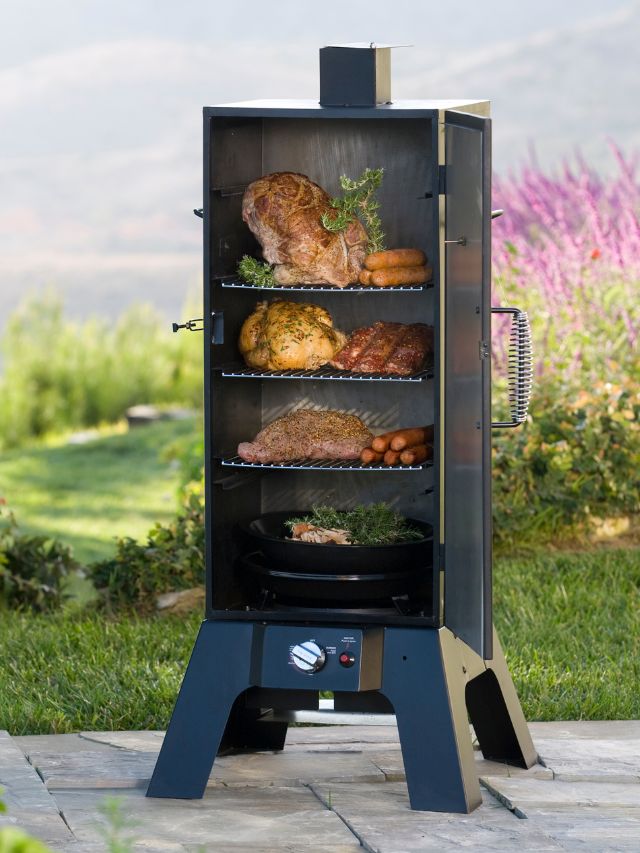
Some types of vertical smokers combine the best of both worlds, employing a vertical offset smoker design that incorporates the compact size and limited space of a traditional vertical smoker with the heat management benefits of an offset smoker for great results.
Set Up Anywhere
Vertical smokers and offset smokers have different sizes.
Due to their smaller size, vertical smokers can be easily set up in various locations, unlike offset smokers, which require more space for their large cooking chamber and firebox.
Maintenance
Offset smokers typically need more maintenance than vertical smokers, as they have a larger smoker (or cooking chamber) and firebox, which require regular cleaning to prevent buildup and ensure efficient heat distribution.
Choosing between a vertical or offset smoker depends on the individual’s needs, personal preferences, available space, and budget.
Careful consideration should be given to each smoker’s design, orientation, cooking capacity, and features to find the perfect fit for your BBQ needs.
Advantages and Disadvantages
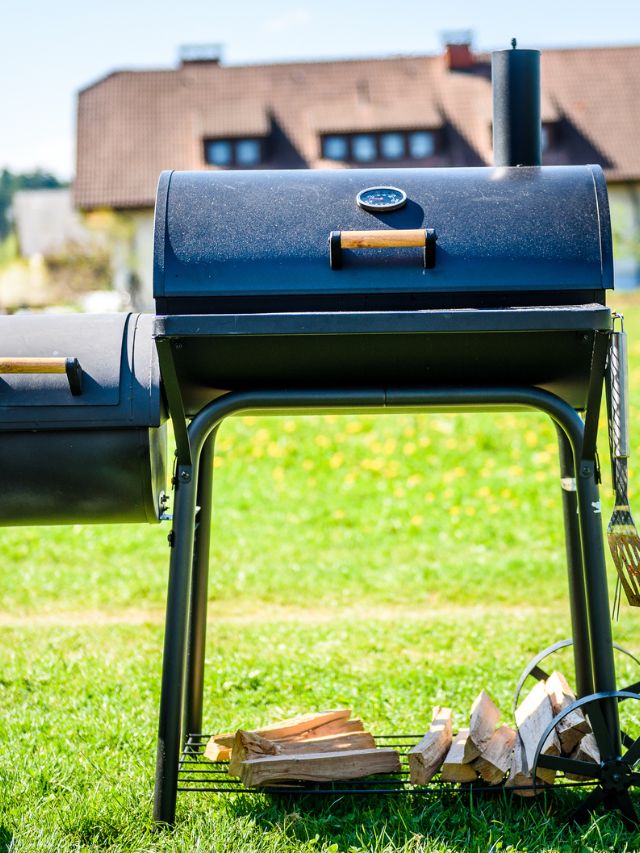
Pros and Cons of Offset Smokers
Offset smokers have their own unique advantages and drawbacks.
Some of the pros of using offset smokers include:
- Cooking Style: Offset smokers provide an authentic smoking experience and are able to produce a delicious smoky flavor in the food.
- Ease of Use: The large cooking area makes it easy to add, remove, and rotate food. The open design of an offset smoker makes it more user-friendly for cooking and handling multiple meats at once. You can put the food on pull-out food trays and easily place them on smoker grills.
- Affordability: Offset smokers are generally more affordable than vertical smokers, making them a good choice for people starting out smoking.
However, there are some cons to consider:
- Maintenance: Offset smokers may require more upkeep due to their complex design, and they may have more parts that can wear out over time.
- Energy Efficiency: Offset smokers are less fuel-efficient than vertical smokers, which might result in higher fuel costs.
- Small Space: This type of smoker is not ideal for small spaces, as they can be quite large and take up more room.
Pros and Cons of Vertical Smokers
Vertical smokers also have their advantages and disadvantages.
Some of the pros of using vertical smokers include:
- Portability: Vertical smokers, such as vertical water smokers and ugly drum smokers, are typically smaller and lighter than offset smokers, making them easier to move around.
- Energy Efficiency: These types of smokers are generally more fuel-efficient than offset smokers, resulting in less fuel consumption.
- Cooler Climates: Vertical smokers are better suited for cooler climates than offset smokers, as they can maintain a consistent temperature more easily.
Some of the cons to keep in mind are:
- Cooking Style: Vertical smokers can have a trickier cooking process due to their design, which may make rotating and handling food more difficult than in an offset smoker.
- Dual-Door Design: Some vertical smokers lack a dual-door design, which can make adding fuel more challenging and may require you to move your food around in the process.
Both offset and vertical smokers have their pros and cons.
Your choice will depend on factors like budget, space, portability, and your preferred cooking style.
Best Use Cases and Cooking Preferences
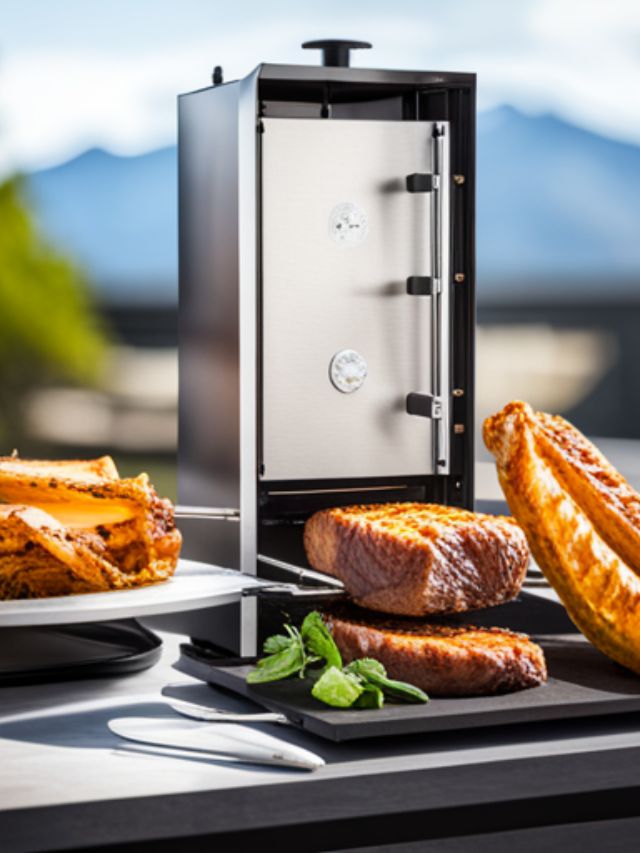
Choosing the Right Smoker for Your Needs
When considering whether a vertical smoker or an offset smoker is best for your BBQ and smoking needs, it’s essential to evaluate the specific advantages of each type and the main difference between the two.
Here, we will present a brief comparison of these two popular smoker types:
- Space: Vertical smokers have a smaller footprint due to their design, making them suitable for those with limited outdoor space. Offset smokers may require more placement area.
- Temperature Control: Offset smokers made out of stainless steel can handle both low-and-slow and high-heat cooking at maximum temperature on a thick steel plate, providing versatility for various meat types. Vertical smokers typically offer more consistent temperatures due to their design but may be better suited for cooler climates or low temperatures.
- Fuel Efficiency: Vertical smokers use much less fuel than offset smokers, which can be a cost-saving factor for some users.
- Usability: Vertical smokers are user-friendly and easy to maintain, making them a good choice for BBQ beginners or busy grill masters. Offset smokers may require more frequent tending during the cooking process.
Smoking Meat
Regardless of the smoker type you choose, here are some valuable tips for smoking various popular meats:
- Pork: Select a tough cut, such as pork shoulder or ribs, that will benefit from the low-and-slow cooking process. Use a mix of wood chips or pellets for a well-rounded smoky flavor.
- Chicken: Brine the chicken before smoking to help the meat retain moisture, ensuring it remains tender and juicy. Choose a lighter wood, such as apple or cherry, to avoid overpowering the chicken’s natural flavors.
- Searing: Offset smokers are more suitable for searing due to their ability to reach high heat temperatures quickly, while vertical smokers may not provide the same level of direct heat required for a crisp, crusty sear.
- Outdoor Cooking Accessories: Invest in proper cooking racks, digital thermometers, and heat-resistant gloves for the best smoking experience.
- Temperature Management: Monitor the smoker’s internal temperature and adjust the vents or fuel supply accordingly to maintain consistent cooking temperatures.
The best use cases and cooking preferences will influence whether a vertical or offset smoker is the ideal choice for you.
Consider aspects such as space, temperature control, fuel efficiency, and usability when making your decision.
And remember, no matter which smoker you choose, follow the proper smoking techniques and tips for a delicious BBQ experience.
Tips to Remember

In the debate between vertical and offset smokers, each type presents its own set of advantages and drawbacks.
It ultimately boils down to the user’s preferences and needs.
Vertical smokers are known for infusing a delicious, smoky flavor into the meat and are popular in competitive cooking.
They are also more consistent and easier to control, making them a better option for smaller groups or those new to smoking.
On the other hand, offset smokers offer versatility by allowing users to smoke and grill in the same unit.
They are generally more economical than vertical smokers and suit those who need larger cooking capacities to cook for large gatherings.
Here’s a breakdown of the pros and cons in a tabular form for easy comparison:
| Points of Comparison | Vertical Smokers | Offset Smokers |
| Flavor | Delicious, smoky flavor | Good, but not as smoky as vertical smokers |
| Capacity | Smaller groups | Larger groups or parties |
| Consistency | More consistent temperatures | Less consistent and harder to control temperatures |
| Operating Ease | Easier to control and use | Might require more expertise or effort |
| Versatility | Primarily built for smoking | More versatile, can smoke and grill |
| Price | Usually more expensive | More budget-friendly |
The decision between vertical vs offset smokers depends on factors like budget, versatility, cooking capacity, and desired level of smoky flavor.
It’s important to make a vertical smoker comparison to the offset smoker in order to be aware of the similarities between these two smokers, while you also keep their differences in mind.
By evaluating these aspects, one can determine which smoker best fits their needs and personal preferences.
Final Thoughts
When comparing vertical and offset smokers, it’s important to consider factors such as heat distribution, cooking capacity, and personal preference.
Offset smokers, including a horizontal offset smoker and reverse flow smoker, feature a separate firebox and allow for indirect heat and smoke flow through the smoking chamber.
This design, often referred to as stick burners, offers excellent flavor and control.
On the other hand, vertical smokers distribute heat from the bottom of the smoker, making them more compact and efficient in terms of space.
When researching the best offset smokers, be mindful of affiliate links, as they may generate commissions for the author.
Ultimately, the decision between a new smoker depends on your desired cooking style and capacity needs, as both options provide the opportunity to create delicious and flavorful dishes.

Get the scoop on more like this:






